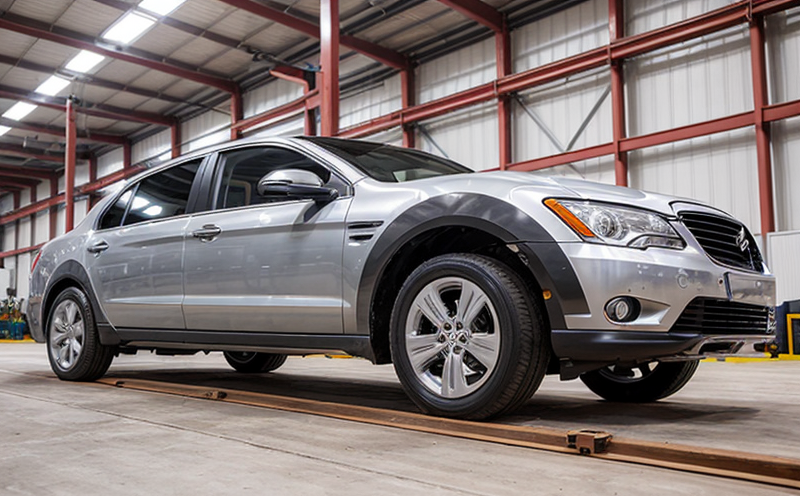ASTM E290 Bend Testing of Manufactured Materials
The ASTM E290 standard specifies a method for determining the bend properties of metallic materials. This test is crucial in evaluating the mechanical integrity and structural reliability of manufactured components, especially those subjected to bending stresses during their operational lifecycle. The primary objective of this testing method is to assess whether the material can withstand bending without failure, which is critical in industries such as aerospace, automotive, and heavy machinery where structural integrity is paramount.
The ASTM E290 bend test involves placing a specimen between two rollers or anvils and gradually applying a bending load until the specimen reaches its yield point. This process provides valuable insights into the material's ductility, strength, and overall quality. By understanding these properties, manufacturers can ensure that their products meet strict performance standards and are fit for purpose in various applications.
The test is not limited to metallic materials but can also be applied to other manufactured components made from various materials such as plastics, composites, and alloys. This versatility makes the ASTM E290 bend test a versatile tool across multiple sectors including industrial manufacturing, construction, and even consumer goods where structural integrity must be maintained under stress.
One of the key aspects of this testing method is the precise control over the bending radius and load application rate. These parameters significantly influence the outcome of the test, making it essential for accurate specimen preparation and consistent testing conditions. The ASTM E290 standard provides detailed guidelines on how to prepare specimens correctly, ensuring that any observed failures are due to material properties rather than improper testing.
The results of the ASTM E290 bend test provide critical information about a material's bend limit, which is the maximum bending angle without causing permanent deformation. This value is crucial in designing products and selecting materials for specific applications where bending stresses are expected. By understanding these limits, engineers can optimize their designs to ensure that components remain functional under anticipated loads.
In addition to its role in quality assurance, ASTM E290 bend testing also plays a key part in research and development efforts aimed at improving material performance. Researchers use this test to explore new materials or modify existing ones to enhance their bending properties. This ongoing innovation ensures that industries can continually improve the reliability and efficiency of their products.
The ASTM E290 standard is widely recognized for its accuracy and consistency, making it a trusted method in many sectors. Its broad applicability across different industries underscores its importance as a fundamental test in mechanical engineering and materials science.
Applied Standards
| Standard | Description |
|---|---|
| ASTM E290 | This standard specifies the procedure for determining the bend properties of metallic materials. It is used to evaluate the mechanical integrity and structural reliability of manufactured components. |
| ISO 14615:2003 | An international standard that provides a method for determining the flexural strength of plastics, which can be compared with ASTM E290 when testing similar materials. |
| EN 10278-1 | This European standard specifies the procedure for determination of tensile properties at elevated temperature of metallic materials, which is related to the thermal stability of materials tested by ASTM E290. |
| IEC 62368 | An international standard that provides requirements and test methods for electrical insulation. It can be relevant when testing insulating materials subjected to bending stress. |
Environmental and Sustainability Contributions
The ASTM E290 bend test contributes significantly to environmental sustainability by ensuring that products are designed with durability in mind. By assessing the mechanical integrity of materials before they enter manufacturing processes, this test helps prevent waste by identifying substandard materials early on. This leads to reduced material usage, lower production costs, and ultimately less waste sent to landfills.
Moreover, the ASTM E290 standard is part of a broader framework that promotes sustainable practices in industrial manufacturing. By ensuring that only high-quality materials are used, this test helps manufacturers meet environmental regulations and improve their overall sustainability performance. This not only enhances the reputation of the manufacturer but also aligns with global efforts to reduce carbon footprints.
The test also supports recycling initiatives by confirming that materials can withstand the rigors of manufacturing processes without failure. This ensures that recycled materials are just as reliable as virgin ones, promoting a circular economy where resources are used more efficiently and effectively.
Competitive Advantage and Market Impact
The ASTM E290 bend test provides significant competitive advantages in the industrial manufacturing sector. By ensuring that products meet stringent quality standards, manufacturers can build trust with their customers, leading to increased market share and customer loyalty. The ability to demonstrate compliance with international standards such as ASTM E290 also positions companies as leaders in their field, attracting more business from discerning clients who prioritize quality.
In addition to enhancing brand reputation, the test results provide valuable data that can be used for continuous improvement of products. This not only improves product reliability but also differentiates a company's offerings from those of competitors. By consistently delivering high-quality products, manufacturers can maintain their competitive edge and command premium prices in the market.
The ASTM E290 standard is particularly relevant in highly regulated industries such as aerospace and automotive, where safety and performance are critical factors. Compliance with this standard demonstrates a company's commitment to excellence, which is increasingly becoming a differentiator in these sectors. As regulatory bodies continue to tighten requirements for product quality and safety, being ahead of the curve by adopting standards like ASTM E290 can provide a significant competitive advantage.





